A cervical osteochondrosis is a disease that is difficult to diagnose if the patient's initial treatment for the doctor due to a large number of signs and a slow -hearted course of the disease.
Development and manifestation of pathology
Osteochondrosis of the cervical spine can be found in people who have a seated lifestyle and have a seated work.
Sign
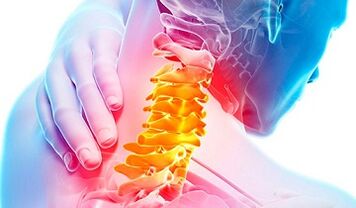
Signs of osteochondrosis of the cervical vertebrae are not only pain in the neck area and in the upper shoulder zone, but also headache, chest pain.
A distinction is made between several syndromes, each of which is characterized by its own characters.
Rooser syndrome is due to a clamping of the nerve endings in the intervertebral disc of the cervix rooms.Characteristic features:
- Pain in the cervix region;
- Pain in the forearm and the hands;
- The sensations of tingling, numbness in the forearm.
Cardial syndrome (or heart syndrome) is due to a violation or irritation of the roots of the nerves of the diaphragm and (or) large chest muscles.In this case, the signs serve as pain in the heart area, which will be lengthy in the event of rotation of the head, sneezing or other neck movements (as in the case of angina pectoris).
Vail arteries syndrome.Signs of osteochondrosis in this case are:
- Pulsating headaches in the occipital, frontal (over eyebrows) and time that are constant;
- Diseases of the hearing aid, the vestibular apparatus, seeing (if osteochondrosis is already in a neglected state).
Iriture reflex syndrome.Signs of such a syndrome are:
- pulsating pain in the occipital part of the head;
- Pain in the cervical part, which runs even deeper to the chest or spreads to the side, in the shoulder joint;
- Reinforcement of the pain after sleep, sharp movements of the head (including sneezing, cough).
Symptoms
The symptoms in the development of osteochondrosis depend on which nerve roots are damaged.In the neck region 7 vertebrae between which there are nerves.Your damage causes pain in developing osteochondrosis.

The vertebrae are viewed from top to bottom and displayed by Roman numbers (CI, CII).The nerve ends between them are viewed in a similar way and referred to by Arabic digits (C1, C2).The letter C denotes a cervix department (from Latin the Cervical).
- In the event of damage to the nervous end between the first and the second vertebra (C2), the main symptom is deafness and loss of sensitivity in the Occipital part.Later - pain there.
- The damage to the nerve end (C3) between the second and third vertebra leads to an impairment of sensitivity in the region and later leads to an impaired sensitivity and impairment of the language (until language impairment).
- Damage to the nervous end between the third and fourth vertebrae (C4).In this case, the pain concentrations concentrate in the collarbone, go to the area of the heart and impair breathing impairments are possible.But pain is preceded by a feeling of deafness in the collar and shoulders.
- Damage to the nerve root of C5 between the fourth and fifth vertebrae.In the event of damage, it reacts with the impairment of the sensitivity of the limbs, both in the upper (on the hands) and the lower, as well as the bottom of the forearm and the outer part of the shoulder.
- Damage of the nerve that ends in the area of the fifth, sixth and seventh vertebrae (the most common neck osteochondrosis).The symptoms of clamping the nerve end of C6 and C7 are regular deafness of the fingers and hands, pain in the neck, forearm and below - the shoulder blade, back to the lumbar spine.
- Damage to the nerve C8.The pain concentrates in the neck and spreads through the forearm to the elbow and on the back to the lower extremities.In pain, loss of sensitivity is in considerable areas of the hands (fingers, brushes), legs (fingers, feet) and skin ahead.The blood circulation in the limbs is disturbed, which influences the skin color of the hands and feet.
Reasons

Cervical osteochondrosis is increasingly found in the young population.The reasons that explain the occurrence of the disease are more common to the wrong way of life than to an inherited predisposition.
Among the hereditary causes is not only a genetic predisposition to the disease, but also the presence of chronic diseases, hereditary anomalies of the development of the spine.
The list of causes of osteochondrosis of the cervical vertebrae connected to the way of life is very wide.This includes:
- Improper nutrition and consequently the excess body weight, a disturbed metabolism in the body, a lack of vitamins and minerals.
- A sitting lifestyle caused by sitting or uniform work.Unstable physical activity.
- Heavy physical activity.This includes professional sports and frequent lifting of weights.
- The curvature of the spine, violation of the attitude, consequences of spine injuries, developed flat feet.
- Tension, frequent nerve pollution.
Diagnosis
The diagnosis of osteochondrosis should only be made by a doctor.
Visual diagnostics
When contacting a neurologist and an orthopedic doctor, an examination and an overview of the patient are carried out.After the palpation, the evaluation of the mobility of the neck and pain degree, the patient is geared towards hardware diagnostics.
Radiography
The method will help identify changes in the cervix region and to determine your conclusion.For a more precise diagnosis, it is possible to use the functional radiography if images of the cervical spine are taken in different poses, which contributes to "capture" changes in the intervertebral disc from several pages.
Magnetic resonance imaging
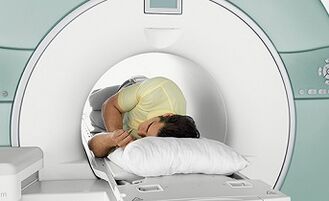
The method using magnetic pulses to obtain a tomogram in which not only pathologies in the structure of vertebrae and between vertebral bodies, but also the presence of hernias between vertebrae, their size and position are identified.
When using MRI in the results of the diagnosis, changes in the vascular system and in the nerve ends of the vertebral department are visible.
Computed tomography
This is a detailed analysis of the state of vertebrae using tomography and computer processing of the result.The method not only makes it possible to identify changes in the vertebrae and the intervertebral disc rooms, but also the condition of the soft tissue, blood vessels and ligaments.
Differential diagnosis
After sending to one of the diagnostic procedures, the doctor carries out a differential diagnosis - it excludes the presence of other diseases in the body that have similar symptoms.This requires a blood test, a transfer to other medical specialists.
What is dangerous to ignore osteochondrosis?
Cervical osteochondrosis has remission and deterioration periods.Unexpected people often feel without going to the doctor in good time and using painkillers, relief and forget the problem until the next exacerbation.However, the disease develops and, if you continue to ignore obvious symptoms, lead to serious complications in the cervix region.
Among the first and thus relatively "mild" consequences of the introduction of osteochondrosis of the cervix region, a lead and hernia of the intervertebral discs are differentiated.
In the first case, the intervertebral disc protects its shift from the normal place between the vertebrae.At the same time, the connecting fibers in the intervertebral disc (fiber ring) remain intact and intact.
The suggestion in the cervical spine is serious even with a size of up to 1 mm, while in other parts of the spine, these changes are not so dangerous.
After the formation of ahead, the destruction influences the fibrous ring and combines fibers that protect the inner coat of the pulposkerne.Pathological changes in these structures lead to the formation of hernia of the intervertebral disc.The formation and development of hernia is accompanied by increasing pain syndromes and unpredictable consequences.
The more serious consequences of osteochondrosis are, if there is no treatment, vascular disorders: Vegetovascular dystonia, high blood pressure and hypotension.
The formation of hernias of the intervertebral disc leads to a violation of the right place and the functioning of blood vessels, whereby the arteries that feed the brain presses.This leads to a violation of the oxygen recording in the brain and its normal work contributes to the formation of blood clots in vessels with another gap.The result of the development of the disease is a stroke.
First aid
With the tightening of osteochondrosis, the first question with which the patient is confronted is: "How will it get rid of pain in the cervix region?"
Medicines that contain analgesics and pain relievers help to eliminate the sensation of pain, and the restriction of movements helps with movements.
If acute pain passes, the next few hours and days in front of the doctor can use anti -inflammatory pain relievers.You can use heat ointments in times of a deterioration decline.They help relieve the tensions in the neck and distract from painful pain.The ointments should be applied with light movements without massage.
If a pain attack in the cervical spine found it far from the first kit, like an applicator, a pepper stain, the mustard and a sand bag can help.

The applicator should be placed on a flat surface so that it is located under the cervix department, the occipital part of the head and the shoulder connection.A few minutes have to suffer pain on the skin.Lying on the applicator should be 2-3 times a day 30-40 minutes.
Pepper stain or mustard, you can use a bag with warm sand.You should apply to the painful point on the neck and leave for a few minutes.Heat relaxes the muscles and distracts the irritation of pepper or mustard in front of pain.
Exercises from training therapy (physiotherapy exercises) that are recommended for cervical osteochondrosis are able to reduce pain, but by a gentle period.Exercises should be carried out regularly during remission times - this will contribute to the quick treatment and reduction of the severity and frequency of deterioration in the disease.
After receiving first aid and removing pain, you have to seek help from doctors as soon as possible.
Treatment
The treatment of osteochondrosis is carried out using various methods.
Traditional medicine
Medicinal treatment is popular and effective.
Drug treatment
Anesthesia tablets are used during the time of osteochondrosis worse and are better suited for an ambulance for the patient.In such cases, analgesics are used.
Treatment is carried out by other drug -not -steroidal anti -steroid medication (NSAIDS).
Modern medicine uses a new type of medication - chondroprotectors - medication that restores cartilage tissue.
During the time of worsening the disease, doctors prescribe injections that not only relieve pain, but also have an anti -inflammatory effect.
Blockade of pain syndrome
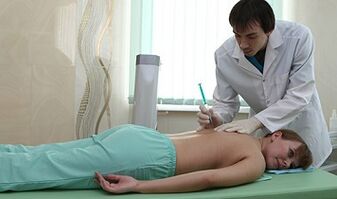
In advanced cases, it can be resistant while tightening pain syndrome against analgesics and even injections of painkillers.Then the doctor can be carried out by the so -called "blockade" - the introduction of an anesthetics in a source of pain using an injection.Thus, the painful section of the spine is "separated" from the general nervous "composition" and for some time (depending on the individual properties) the pain from this area does not bother the patient.
An experienced medical staff must necessarily carry out the procedure, since an incorrectly completed procedure can lead to complications.The blockade itself has no contraindications except for individual intolerance to drugs and can be carried out as often as the body requires.
Non -traditional medicine
Osteochondrosis is an illness that is not so easy to treat.Therefore, you have to approach this comprehensively.Acupuncture is used in the treatment of osteochondrosis.
Acupuncture is not a method of traditional medicine, but has established itself in the fight against osteochondrosis in that it enables them to alleviate pain and be used in times of exacerbation.It should be remembered that it does not bring acupuncture as such, it reduces the symptoms, helps more easily to transmit time periods of worsening of the disease, to improve the mobility of the neck and joints, and contribute to the recovery and regeneration activated by exposure to rapid recovery.
Physiotherapy
In addition to drug treatment, doctors recommend performing physiotherapy.
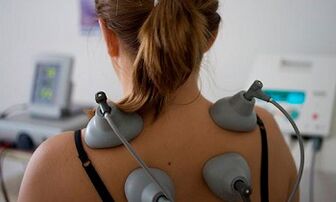
- Electrophoresis.In the case of osteochondrosis, electrophoresis is used with non -steroidal inflammatory and analgesic medicines to transmit the medication to the affected area.The electrical current improves the effect of drugs and the procedure has the treatment.
- ElectrotherapyWith weak electrical currents and magnetotherapy using a magnetic field.They act on miracles, relieve pain and improve blood circulation.Helps in times of remission and triggers the processes of cell regeneration and accelerates the healing process.
Other physiotherapists aim to increase the blood flow to a painful area, reduce edema and inflammation, pain and general strengthening of body state during treatment.
Treatment with ointments
The use of ointments for osteochondrosis is not the main method in treatment and is prescribed as an additional measure that contributes to a quick recovery.The ointments used can be divided into several groups.
- Pain reliever and anti -inflammatory.Such ointments include analgesic and steroids anti -inflammatory substances.
- Warming ointments.The main component of such ointments has an irritating effect on the skin, which increases blood supply to the area.This relieves stress, swelling, reduces pain.
- Chondroprotectorsin the form of ointments.The active substances restore the cartilage tissue, and the auxiliary carriers are relieved of inflammation and pain.
- Massage albums.Ointments for massage and self -massage.There are natural anti -inflammatory substances, analgesic substances, a complex regenerating substances of plant origin.
Massage and self -massage
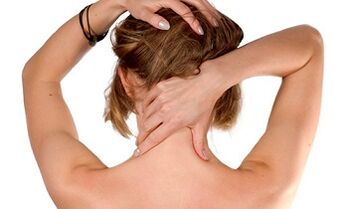
A massage with osteochondrosis of the cervical spine is necessary during the remission period of the disease so as not to increase the pain during the procedure.The massage is prescribed by a course of ten to fifteen sessions and no more than once in the quarter.The massage for cervical osteochondrosis is used as a procedure that reinforces the effect after treatment and prevents osteochondrosis.
The massage of the collar zone and acupressure at the scene of the disease takes place by a specialist.The clear movements of the massage therapist help to knead the muscles of the neck, improve the bloodstream, relieve the tension and to strengthen the neck muscles after the massage course, which maintains the preventive effect for several weeks and even months.
If necessary, you can carry out a light massage yourself.It is necessary to knead and grind the muscles of the neck, background part and the shoulder muscles.Simple movements in a comfortable position and at any time there can be an addition to the treatment and prevention of the osteochondrosis of the cervical spine.
Self massage is recommended for a few minutes a day.It has no contraindications, and pain accompanied by movements is easily controlled by the patient.
Real nutrition
In addition to the classic treatment, physiotherapy methods and massages for the treatment and prevention of osteochondrosis of the cervical spine, a proper diet with a full range of vitamins and minerals is required.

The most important in this matter are vitamins A and C that strengthen the vessels.Vitamins B6 and B12 improve the metabolism and the amino acids in the body, help the nervous system, correctly and without errors.
Complex vitamins are required for the general restoration and strengthening of the body during the remission period.
Traditional medicine
People's funds for the treatment of cervical osteochondrosis are divided into those that alleviate pain and can be used for exacerbations.
Anaesthesia potato compress
You need:
- Potato;
- Honey-1-2 el.Tablespoon for a potato.
Preparation and application:
- Clean raw potatoes, rub.
- Mix smooth in a flat bowl with honey.
- Place the resulting mass in a painful point, cover it with polyethylene and fix it with a diaper.Keep a compress for 1-2 hours.
Infusion of radish radishes for anesthesia
Alcohol indices in folk medicine are not only used to rubbing painful actions for anesthesia, but also for oral administration for a general strengthening effect and relief.
For the infusion of radishes on vodka you need:
- Black radishes - half a medium -sized size;
- Vodka-50-70 ml;
- Honey –3-4 tablespoons.Tablespoon;
- Salt - 2 tablespoons.Tablespoon.
Preparation and application:
- Peel the radishes, roughly roughen on a fine grater.
- Mix smooth in a flat bowl: grated radishes, honey, salt, vodka.
- Grate the cervix department with the mixture twice a day during the exacerbation with the mixture.
- Take 1 teaspoon in the empty stomach twice a day during a deterioration.
Analgetic ointment for ginger deductions
You need:
- Ginger powder - 1 tablespoon.Spoon;
- Knoblauch-2-3 cloves;
- Butter.
Preparation and application:
- Fry in ginger powder in a pan in a small amount of butter.
- Peel the garlic, grate on a fine grater or grind with a swarm.
- Mix fried ginger powder and garlic in a flat bowl.
- The resulting ointment can be grated into a painful stain with exacerbations or used as a compress that are bound with a diaper for a few minutes until there is a burning feeling on the skin.
Oil with garbage to rub
The oil rows with a light massage for osteochondrosis is used in remission times of the disease and carried out with courses for 10-15 days with a break.
You need:
- Oregano (grass) - a handful;
- Olive oil (can be sunflower) 300-500 ml.
Preparation and application:
- Finely shake pain (grass).
- Add oregano to a bottle of oil and let it infuse it in a dark place for at least a day.
- Strain the oil and press Oreegano from oil.
- Use the infused oil for rubbing and light massage of the area affected by osteochondrosis once.
Night compress from horseradish
You need:
- Handerettish leaves 1-3Pcs.;
- Boiling water.
Preparation and application:
- Immerse yourself in boiling water (soft) for a few seconds.
- Soft soft leaves on the place affected by osteochondrosis, which is bound with a diaper and insulation with a scarf.
- Leave the compress out of the leaves of the horseradish at night.The feeling of light clamping is quite acceptable.
- The procedure takes place during the disease with a course of 5-7 procedures with a break for 2-3 weeks.
Lemon shift cocktail
You need:
- Lemon - 1 PC;
- Knoblauch-1 head (5-6 cloves);
- Boiling water.
Preparation and application:
- Peel the lemon out of the bowl, grind the seeds with a blender or go through a meat loop.
- Peel the garlic, grind with a swarm or yell on a fine grater.
- Mix lemon and garlic in a glass or a large bottle and pour a mixture of 0.5 liters.Boiling water.
- Insist on the resulting mixture of at least 12 hours (go overnight).
- The resulting lemon cheese cocktail is consumed in a half glass on an empty stomach every day in the morning.
You can keep a cocktail in the fridge that is prepared if necessary.The course of a cocktail is 1 month.
Strawberry tea
You need:
- Forest strawberries (fresh or dried) - 1 tablespoon.Spoon;
- 1 cup of boiling water.
Preparation and application:
- Boden -stawed berries pour boiling water like tea.
- Exist at least 10-15 minutes.
- Drink with osteochondrosis of 2-3 cups a day.
Medical physical education
One of the causes of osteochondrosis is hypodynamy - the lack of physical activity against the background of a seated lifestyle.Only a few simple exercises will help to alleviate the tightening of the disease or prevent its appearance.
Exercises "for home and office"
Resistance
- Press the hand surface onto the occipital part of the head Press the neck muscles.To resist with one hand.Perform a voltage of 10 seconds.
- Change the position of the hand, put it on the forehead and now try to put on the front.Also against 10 seconds resistance.
- Change the position of the hand and put it with a palm of the temple (right hand on the right temple) and also resist the pressure of the hand on your head.Perform a voltage of 10 seconds.
- Change the hand and the application of the exercise to resist the left (left hand on the left temple).Perform a voltage of 10 seconds.
- Change the situation alternately and repeat the exercise up to 5 times for each hand position.
Standing of the head of the head
- Stand straight and stretch your shoulders.
- Make the head heads alternately as far as possible to the right and left.
- Sink your head to the chin to the neck.
- Make the same curves as much as possible with your head on each side, slowly and without tearing the chin out of the throat.
- Slowly carry out the exercise, repeatedly on each side in each position up to 5 times.
Includes of the head
- Rest your shoulders and throw your head back a little.
- Take your head to the left and right and try to reach your shoulders with your ear.
- Slowly carry out the exercise and repeat up to 5 times on each side.
Exercises were down
Lift the legs
- Put on your back and stretch your arms and legs free.
- Put your legs together, pull your knees on your stomach, pull your head up and try to get your eyes with your knees.
- Sleeping, lowering your head and your legs and arms straighten along the lag along the body.Slowly repeat 5 times.
Turns of the head lie
- Place on your stomach, direct your legs and put your arms along the body.
- Turn your head to the left and try to bring it to the floor with your right ear, and make your head to the right and also try to reach your left ear on the floor.
- Repeat the curves of the head up to 5 times in every direction.
When performing all exercises, it should be remembered that when manifesting pain, you should refuse to perform the exercise and a doctor.
prevention
The prevention of osteochondrosis of the cervical spine is a healthy lifestyle:
- Sports lessons and sports (moderate).With the tendency towards osteochondrosis, swimming will be the best assistant.It strengthens the muscles of shoulders and neck.
- Balanced diet.Contains a large number of products that contain calcium, magnesium, vitamins (cottage cheese and dairy products, peas and other legumes, nuts, fish and seafood).
- Breaks in sitting.At every opportunity we try to knead the muscles of the neck and back.
- Excessive load.Do not wear much and often the heaviness (including bags on one shoulder).
- Orthopedic pillow and mattress.Use them if possible.
- Not fat.Excess weight accelerates the development of osteochondrosis.Are on the scales more often.
In order to control the condition of the cervix region, it is recommended to make at least every 2-3 years of diagnosis: to carry out an MRI or computer tomography.
In addition, an examination by doctors should be held at least once a year: a surgeon and a neuropathologist.Treating an illness is easier and faster when you start when the first signs occur.


























